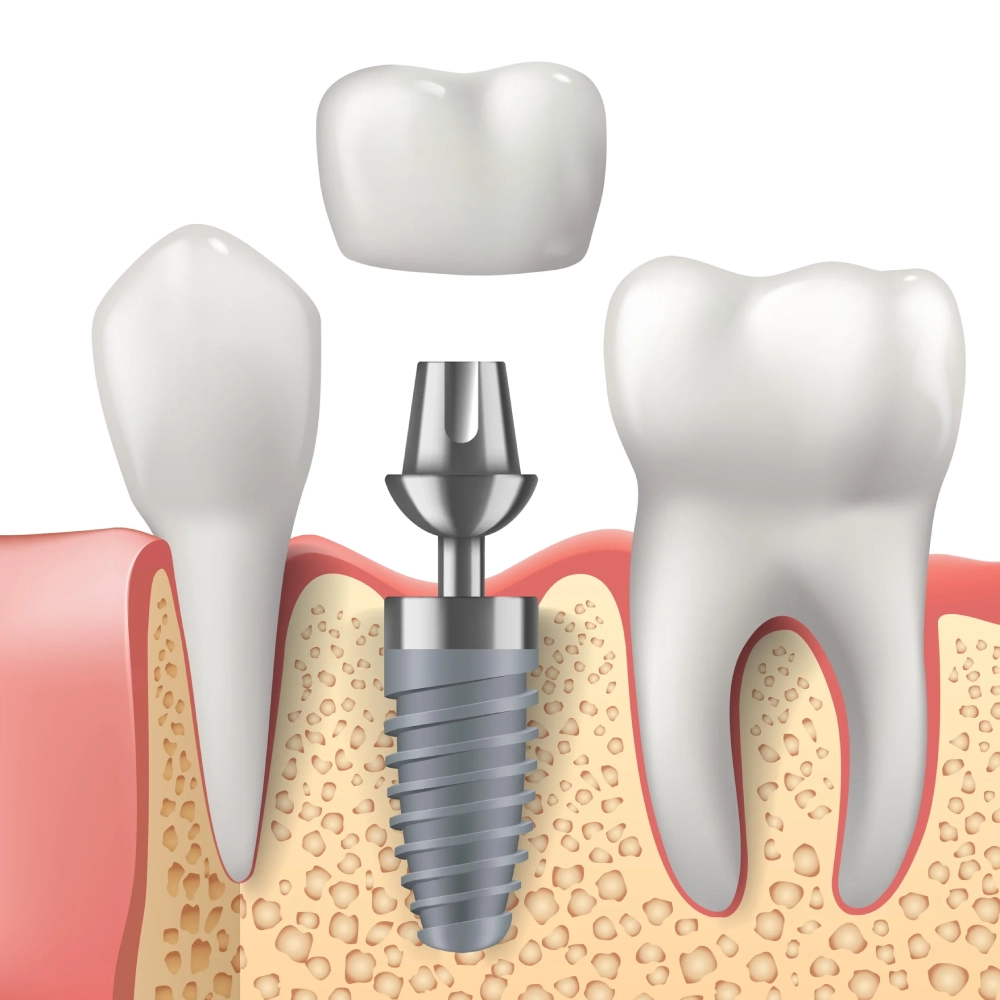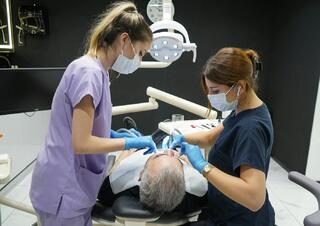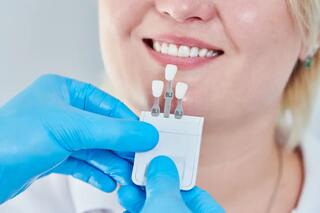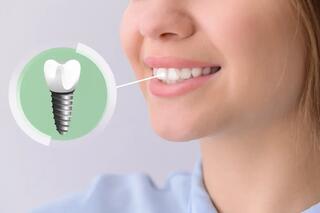Dental crowns are an effective method for restoring damaged teeth. They cover the affected areas and help preserve oral health. This article discusses different types of crowns: metal-ceramic, zirconia, and E-max ceramic crowns, highlighting their pros and cons. It covers the indications for crown placement, including cases of significant tooth damage, deep chips, and cracks. Situations where crowns may not be suitable are also explained. The article further clarifies which crowns are best suited for front and molar teeth.
What Is It?
Dental crowns are a prosthesis that restores the visible part of the tooth (resembling a cap). A crown is placed on a tooth when more than half of the visible surface is damaged. In such cases, a filling is not possible. The damaged tooth must be reinforced, and the healthy tissue and root protected. For severe damage, the prosthesis is placed on a post and core. In cases of complete tooth loss, the crown is placed on an implant.

Indications for Crown Placement
- More than 50% of the tooth is damaged.
- Restoration of a missing tooth.
- The tooth wall is damaged.
- Deep horizontal chips or cracks on the surface (veneers are not an option).
- Severe enamel wear due to bruxism.
Types of Dental Crowns
Metal-Ceramic Crowns
A strong metal structure (framework) is covered with a layer of ceramic to improve aesthetics. Over time, the metal can affect the gum tissue, causing discoloration and potential allergic reactions. To counter this, metal-ceramic crowns with a “shoulder ceramic” (an additional ceramic layer at the gum line) or crowns with a base made of precious metal alloys are used.

Advantages:
- Suitable for molar teeth prosthetics.
- Gold-framed crowns do not shine through the gums.
- Crowns with shoulder ceramic protect the gums from tissue discoloration.
Disadvantages:
- The gum under a traditional metal-ceramic prosthesis may turn blue.
- Gray metal can show through the ceramic (not suitable for front teeth).
Zirconia Crowns
A more expensive, but aesthetically pleasing material. Zirconia dioxide prostheses can be monolithic (standard or Multi Layer) or ceramic-coated. They fully match the shade and translucency of the surrounding natural teeth.
Advantages:
- Indistinguishable from natural teeth (Multi Layer).
- Fully withstand chewing pressure.
- Do not cause allergies or gum irritation.
- Minimal tooth reduction is required for zirconia crowns.
Disadvantages:
- Standard monolithic zirconia crowns are too white and can look unnatural.
- Ceramic-coated crowns may chip.
E-max Ceramic
The most aesthetic material for prosthetics, closely matching the shade of natural enamel. It accurately mimics the color gradient from the tooth base to the cutting edge, making it ideal for the smile zone. E-max ceramics are press-molded using CAD/CAM technology.
Advantages:
- Extremely strong ceramic material.
- Can be color-matched to the tooth shade.
- Biocompatible – does not cause allergies or gum irritation.
Disadvantages:
- Relatively expensive (compared to metal-ceramic crowns).
Which Crowns Are Best for Front Teeth?
When restoring front teeth, it is important to maintain the natural appearance of your smile. Therefore, zirconia or E-max ceramic crowns are the best options, as they are nearly indistinguishable from natural teeth.
You should consider crowns for front teeth if:
- Half of the visible part of an incisor or canine is missing.
- More than 70% of the tooth is missing, but the root is intact.
- The entire tooth is missing, and an implant has been placed.
Which Crowns Are Best for Molars?
The main criterion for selecting a material is its strength. Zirconia or metal-ceramic crowns are suitable. They fully restore chewing function, properly distribute bite pressure, and are resistant to chipping and micro-cracking.
Molars should be restored if:
- There is a large horizontal crack on the tooth.
- A chip has affected 2 or 3 cusps of the tooth.
- One or more walls of the tooth are damaged.
- The gum or jawbone is inflamed.
- The jaw is damaged.
- The dental arches do not align properly.
In these cases, prosthetics can only be done after additional treatment.
Stages of Crown Placement
Thorough preparation is essential for securely placing a fixed prosthesis:
The dentist conducts the first consultation and examination
They examine the oral cavity to assess the condition of the gums, the damaged tooth, and the bite alignment. Afterward, they suggest several options for tooth restoration, discuss the patient’s needs, and listen to their preferences.
-
Prescribes X-rays or CT scans
The image reveals hidden features of the dental and jaw system: the condition of the roots, the depth of carious cavities, the state of the jawbone, and the presence of cysts or granulomas at the root apex. -
Prepares the tooth
The dentist prepares the tooth for prosthetics by treating caries, pulpitis, periodontitis, or other inflammatory conditions. Then they shape the tooth stump as the base for the prosthetic or install a post and core. If the tooth needs to be extracted, they will perform the extraction and then place an implant. The dentist will take impressions or perform a digital scan of the mouth. -
Fixation of the temporary crown
To protect the tooth stump, post and core, or the implant, the dentist secures a temporary crown. It helps maintain aesthetics, speech, and comfort during chewing while the dental technician creates the permanent crown. -
Fitting and installation of the permanent prosthesis
At the next appointment, the dentist removes the temporary crown and fits the permanent one. They cement it onto the tooth stump or post and core using dental cement. If on an implant, the crown can be fixed with cement or a screw-retained mechanism.
Frequently Asked Questions
Why does the tooth under the crown hurt?
There could be several reasons. Pain during the first 2-5 days after the prosthesis placement is a normal bodily reaction. If pain symptoms occur, visit the clinic. If the pain is intense, non-steroidal anti-inflammatory drugs (NSAIDs) can help.
How long does a crown last?
It depends on the material. Metal-ceramic crowns typically last up to 10 years, while zirconia crowns last 15-20 years. If the patient follows the dentist’s recommendations and maintains proper oral hygiene, the lifespan of the prosthesis may increase.
What should I do if the crown falls off?
Schedule an appointment with your dentist as soon as possible. If the crown has fallen off but is not broken, rinse it under running water and disinfect it. Then, promptly visit the clinic to have a new crown placed.
How do I care for a dental crown?
You can eat only two hours after the crown has been fixed. It’s best to choose softer foods. Hard food can damage the prosthesis, so it’s better to cut it or chew on the opposite side at first. You should rinse your mouth regularly. Use a soft or medium-bristle toothbrush and non-abrasive toothpaste when brushing your teeth. Additionally, an oral irrigator can be used. It removes debris from hard-to-reach areas without damaging the crown.




